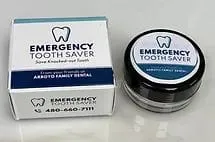Accidents happen and sometimes teeth get knocked out. We have created our own tooth saving kit to hold your tooth until until you can see your dentist. It is much better than the alternatives of milk or storing it in your cheek (gross).
Stop by during business hours to pick up your family's free kit!
How to Save a Tooth
Nearly 5,000,000 teeth are accidently lost each year. That's according to the American Association of Endodontists. That's a lot of teeth. What would you do if confronted with your child or friend losing their tooth? Hopefully that never happens to you but it is good to be ready just in case.
Losing a tooth is a traumatic and stressful event to say the least. You can expect bleeding and shock, and no one knows what to do except you. A surprising fact is that knocked out teeth (avulsed) have a fairly decent chance of surviving and remaining in the mouth for years if handled properly and quickly. The key is protecting and maintaining the health of the tissues attached to the tooth known as the periodontal ligament. Here are 4 simple steps to be the hero in this situation.
- Handling the tooth. Handle the avulsed tooth by the crown or top part of the tooth. The cells of the periodontal ligament can be damaged with excessive pressure.
- Clean the tooth if needed. If the avulsed tooth has visible dirt or debris, it needs to be cleaned off to avoid infection and damaging the tissues. Rinse the tooth quickly with clean water for a few seconds at most. While it is important to clean the tooth, plain water and tissue cells are not compatible and prolonged exposure will damage the cells. You may be thinking that doesn't make sense because about 60% of the body is water. In fact it's not plain water in the body but is mixed with numerous other minerals and electrolytes which makes it compatible with our cells. (This is important for step 4)
- Storing the tooth. The very best place for a displaced tooth is right back in the hole it came from. That means carefully placing the tooth into the socket. It will be bloody and messy and somewhat painful but it is the best solution. The cells have the best chance of surviving back in their natural environment. However for many reasons immediately replacing the tooth is not always possible. The main objective is to keep the cells moist and as stable as possible. The top two readily available alternatives are storing the tooth in the mouth of the person who lost the tooth. Ideally in the cheek area so they do not accidentally swallow the tooth. The other option is to place the tooth in milk. Whole milk is the best although any milk is better than nothing.
There is another solution that is better than mouth or milk and almost as good as placing the tooth back in the socket. It's just not readily available which is something that Arroyo Family Dental is trying to change. Hanks Balanced Salt Solution (HBSS) has been extensively studied and is a great alternative for transporting teeth. It is a salt based solution and does a great job in maintaining cell vitality for short periods of time. We have kits available for free here at our office. They are designed to fit into your first aid kit so it is ready if you ever need it.
- Getting help. Your final step is calling your dentist and scheduling an emergency visit to get the tooth reimplanted. The dentist will reimplant the tooth and then place stabilizing wires and or composite to hold the tooth in place as it heals. The stabilizers will remain in place for 2 to 8 weeks until the tooth is stable.
After a period of time hopefully the tooth stabilizes and becomes solid to chew on and feels normal. Most of the time the tooth will darken as the blood vessels and tissue inside the pulp of the tooth necrose. The tooth will require root canal treatment to fix this. In a successful replantation the ligament cells return to normal, holds the tooth in place and feels and acts like a normal tooth again.

